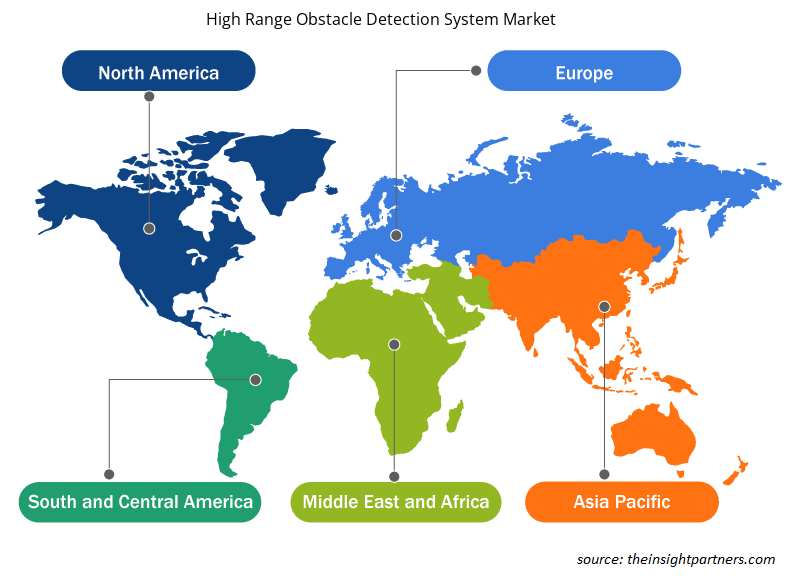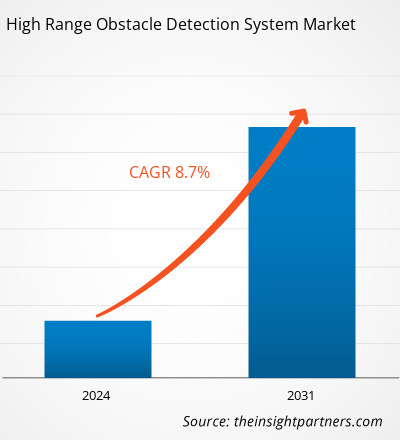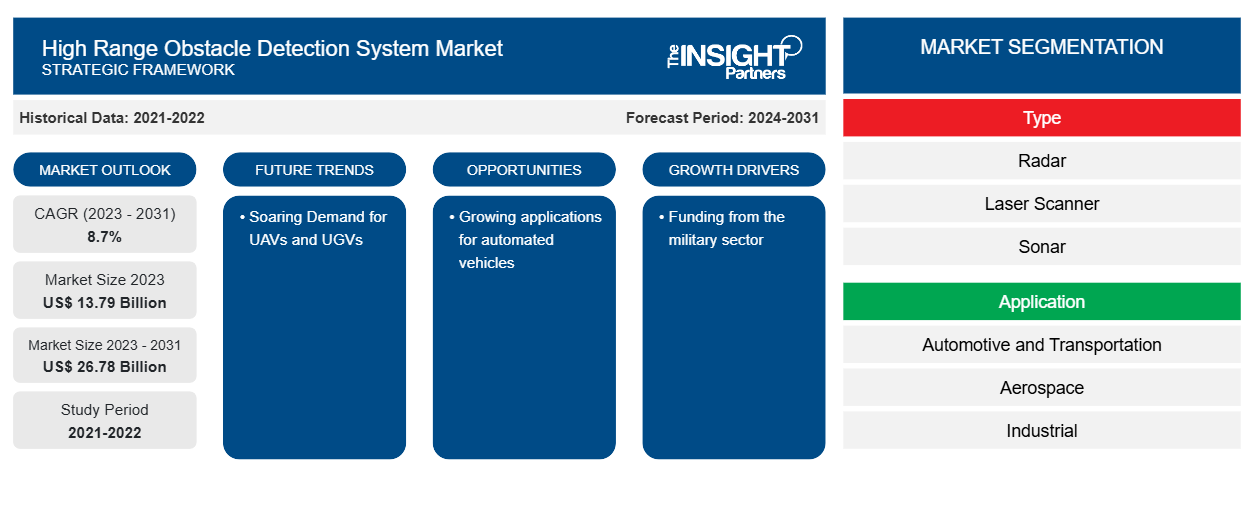Der Markt für Hinderniserkennungssysteme mit großer Reichweite soll von 13,79 Milliarden US-Dollar im Jahr 2023 auf 26,78 Milliarden US-Dollar im Jahr 2031 anwachsen. Der Markt soll zwischen 2023 und 2031 eine durchschnittliche jährliche Wachstumsrate von 8,7 % verzeichnen. Die steigende Nachfrage nach effizienten Hinderniserkennungssystemen im Automobilsektor und die Einführung der LiDAR- Technologie in verschiedenen Branchen dürften weiterhin der Schlüssel zu den Markttrends für Hinderniserkennungssysteme mit großer Reichweite sein.
Marktanalyse für Hinderniserkennungssysteme mit großer Reichweite
Der globale Markt für hochreichweitige Hinderniserkennungssysteme dürfte aufgrund seiner Anwendung in einer Vielzahl von Branchen wie Automobil, Robotik, Luft- und Raumfahrt und Verteidigung schnell wachsen. Zu den wichtigsten Faktoren, die das Wachstum des globalen Marktes für hochreichweitige Hinderniserkennungssysteme vorantreiben, gehören die steigende Nachfrage nach autonomen Fahrzeugen und ein erhöhter Bedarf an Kollisionserkennung. Technologische Fortschritte bei Sensoren und zugehörigen Komponenten dürften erhebliche Chancen für Marktteilnehmer schaffen.
Marktübersicht für Hinderniserkennungssysteme mit großer Reichweite
Eine zuverlässige Hinderniserkennung mit großer Reichweite ist für schnell fahrende, sicherheitskritische Plattformen wie autonome Autos von entscheidender Bedeutung, um in Echtzeit auf Gefahren reagieren zu können. Ein Hinderniserkennungssystem mit großer Reichweite erkennt Hindernisse wie Bäume und Gebäude aus der Ferne. Es funktioniert, indem es Sensoren wie Radar, Kameras und Laser verwendet, um die Höhe und Objekte in der Umgebung zu messen und den Benutzer zu benachrichtigen, wenn ein Hindernis erkannt wird. Diese Systeme werden in einer Vielzahl von Anwendungen eingesetzt, darunter Fahrzeug- und Flugzeugnavigation, militärische Erkennung, Vermeidung von Landminen und andere.
Passen Sie diesen Bericht Ihren Anforderungen an
Sie erhalten kostenlos individuelle Anpassungen an jedem Bericht, einschließlich Teilen dieses Berichts oder einer Analyse auf Länderebene, eines Excel-Datenpakets sowie tolle Angebote und Rabatte für Start-ups und Universitäten.
-
Holen Sie sich die wichtigsten Markttrends aus diesem Bericht.Dieses KOSTENLOSE Beispiel umfasst eine Datenanalyse von Markttrends bis hin zu Schätzungen und Prognosen.
Markttreiber und Chancen für Hinderniserkennungssysteme mit großer Reichweite
Finanzierung aus dem Militärsektor zugunsten des Marktes
Das High Range Obstacle Detection System ist ein hochentwickeltes Erkennungssystem, das sowohl Radar- als auch Sichttechnologien nutzt, um Hindernisse und Gefahren aus großer Entfernung zu erkennen. Es wird in militärischen Anwendungen wie Drohnen, Bodenfahrzeugen und Schiffen eingesetzt. Dieses System verwendet fortschrittliche Sensoren, die dabei helfen, Hindernisse in Echtzeit zu erkennen. Diese fortschrittliche Technologie trägt dazu bei, die Effizienz von Drohnen, unbemannten Oberflächenfahrzeugen ( USV ) und anderen zu verbessern. Für den Einsatz dieser Technologie im Militärsektor werden die Marktteilnehmer vom Militär finanziert, um technisch fortschrittliche Lösungen zu entwickeln. So erhielt KEF Robotics im Dezember 2023 vom US-Verteidigungsministerium Mittel, um eine KI-gestützte Hinderniserkennungslösung für angebundene Drohnen der US-Armee zu entwickeln.
Zunehmende Einsatzmöglichkeiten für automatisierte Fahrzeuge
Der Markt für automatisierte Fahrzeuge und selbstfahrende Systeme wächst, da sie sicherere und effizientere Transportmöglichkeiten bieten. Die automatisierten Fahrzeuge erzeugen eine Nachfrage nach Hinderniserkennungssystemen, was wiederum die Nachfrage nach Hinderniserkennungssystemen mit großer Reichweite zur genauen Erkennung von Hindernissen fördert. Mit der Einführung dieser Lösung erkennt das Fahrzeug Hindernisse schnell und reagiert entsprechend. Diese Funktion erhöht die Sicherheit autonomer Fahrzeuge.
Marktbericht über Hinderniserkennungssysteme mit großer Reichweite – Segmentierungsanalyse
Schlüsselsegmente, die zur Ableitung der Marktanalyse für Hinderniserkennungssysteme mit großer Reichweite beigetragen haben, sind Typ und Anwendung.
- Je nach Typ ist der Markt in Radar, Laserscanner , Sonar und LiDAR segmentiert. Das LiDAR-Segment dürfte die höchste durchschnittliche jährliche Wachstumsrate aufweisen.LiDAR. The LiDAR segment is expected to grow with the highest CAGR.
- Nach Anwendung ist der Markt in Automobil- und Transportwesen, Luft- und Raumfahrt, Industrie, Schifffahrt und andere Anwendungen unterteilt. Das Automobil- und Transportsegment hielt im Jahr 2023 einen größeren Marktanteil.
Marktanteilsanalyse für Hinderniserkennungssysteme mit hoher Reichweite nach Geografie
Der geografische Umfang des Marktberichts zu Hinderniserkennungssystemen mit großer Reichweite ist hauptsächlich in fünf Regionen unterteilt: Nordamerika, Asien-Pazifik, Europa, Naher Osten und Afrika sowie Südamerika/Süd- und Mittelamerika.
Der asiatisch-pazifische Raum wird voraussichtlich das höchste CAGR-Wachstum aufweisen. Der Markt für hochreichweitige Hinderniserkennung wächst in der Region mit der zunehmenden Nutzung von Industrierobotern. Die breite Anwendung der hochreichweitigen Hinderniserkennung in autonomen Fahrzeugen und Drohnen fördert das Marktwachstum zusätzlich.CAGR. The high range obstacle detection market is growing in the region with the rise in the use of industrial robots. The wide application of high range obstacle detection in autonomous vehicles and drones further fosters its market growth.
Regionale Einblicke in den Markt für Hinderniserkennungssysteme mit großer Reichweite
Die regionalen Trends und Faktoren, die den Markt für Hinderniserkennungssysteme mit hoher Reichweite während des gesamten Prognosezeitraums beeinflussen, wurden von den Analysten von Insight Partners ausführlich erläutert. In diesem Abschnitt werden auch die Marktsegmente und die Geografie von Hinderniserkennungssystemen mit hoher Reichweite in Nordamerika, Europa, im asiatisch-pazifischen Raum, im Nahen Osten und Afrika sowie in Süd- und Mittelamerika erörtert.

- Erhalten Sie regionale Daten zum Markt für Hinderniserkennungssysteme mit großer Reichweite
Umfang des Marktberichts über Hinderniserkennungssysteme mit großer Reichweite
| Berichtsattribut | Details |
|---|---|
| Marktgröße im Jahr 2023 | 13,79 Milliarden US-Dollar |
| Marktgröße bis 2031 | 26,78 Milliarden US-Dollar |
| Globale CAGR (2023 - 2031) | 8,7 % |
| Historische Daten | 2021-2022 |
| Prognosezeitraum | 2024–2031 |
| Abgedeckte Segmente |
Nach Typ
|
| Abgedeckte Regionen und Länder |
Nordamerika
|
| Marktführer und wichtige Unternehmensprofile |
|
Marktteilnehmerdichte: Der Einfluss auf die Geschäftsdynamik
Der Markt für Hinderniserkennungssysteme mit hoher Reichweite wächst rasant, angetrieben durch die steigende Nachfrage der Endnutzer aufgrund von Faktoren wie sich entwickelnden Verbraucherpräferenzen, technologischen Fortschritten und einem größeren Bewusstsein für die Vorteile des Produkts. Mit steigender Nachfrage erweitern Unternehmen ihr Angebot, entwickeln Innovationen, um die Bedürfnisse der Verbraucher zu erfüllen, und nutzen neue Trends, was das Marktwachstum weiter ankurbelt.
Die Marktteilnehmerdichte bezieht sich auf die Verteilung von Firmen oder Unternehmen, die in einem bestimmten Markt oder einer bestimmten Branche tätig sind. Sie gibt an, wie viele Wettbewerber (Marktteilnehmer) in einem bestimmten Marktraum im Verhältnis zu seiner Größe oder seinem gesamten Marktwert präsent sind.
Die wichtigsten Unternehmen auf dem Markt für Hinderniserkennungssysteme mit großer Reichweite sind:
- BAE Systems plc
- Blickfeld GmbH
- Collins Luft- und Raumfahrt
- Honeywell International Inc.
- ifm electronic gmbh
- LIVOX
Haftungsausschluss : Die oben aufgeführten Unternehmen sind nicht in einer bestimmten Reihenfolge aufgeführt.

- Überblick über die wichtigsten Akteure auf dem Markt für Hinderniserkennungssysteme mit großer Reichweite
Marktnachrichten und aktuelle Entwicklungen zu Hinderniserkennungssystemen mit großer Reichweite
Der Markt für Hinderniserkennungssysteme mit großer Reichweite
wird durch die Erhebung qualitativer und quantitativer Daten nach Primär- und Sekundärforschung ausgewertet, wobei wichtige Unternehmensveröffentlichungen, Verbandsdaten und Datenbanken einbezogen werden. Nachfolgend finden Sie eine Liste der Entwicklungen auf dem Markt:
- Im Mai 2023 gab das Bosch Engineering Center in Cluj die Installation eines von Bosch entwickelten Kollisionswarnsystems namens Tram Forward Collision Warning (TFCW) in einer Straßenbahn bekannt, die Teil der Flotte der Cluj-Napoca Public Transport Company (CTP) ist. Das System unterstützt Straßenbahnfahrer in kritischen Situationen durch akustische und visuelle Warnungen und erhöht so die Sicherheit für Straßenbahnfahrer, Fahrgäste und andere Verkehrsteilnehmer. Das Straßenbahnkollisionswarnsystem unterstützt Fahrer in kritischen Situationen, indem es sie rechtzeitig vor Hindernissen auf den Gleisen warnt, insbesondere bei dichtem Verkehr oder eingeschränkter Sicht. So können Fahrer Unfälle vermeiden oder Schäden deutlich reduzieren. (Pressemitteilung, 2023)
Marktbericht zu Hinderniserkennungssystemen mit großer Reichweite – Abdeckung und Ergebnisse
Der Bericht „Marktgröße und Prognose für Hinderniserkennungssysteme mit hoher Reichweite (2023–2031)“ bietet eine detaillierte Analyse des Marktes, die die folgenden Bereiche abdeckt:
- Marktgröße und Prognose auf globaler, regionaler und Länderebene für alle wichtigen Marktsegmente, die im Rahmen des Projekts abgedeckt sind
- Marktdynamik wie Treiber, Beschränkungen und wichtige Chancen
- Wichtige Zukunftstrends
- Detaillierte PEST/Porters Five Forces- und SWOT-Analyse
- Globale und regionale Marktanalyse mit wichtigen Markttrends, wichtigen Akteuren, Vorschriften und aktuellen Marktentwicklungen
- Branchenlandschaft und Wettbewerbsanalyse, einschließlich Marktkonzentration, Heatmap-Analyse, prominenten Akteuren und aktuellen Entwicklungen
- Detaillierte Firmenprofile
- Historische Analyse (2 Jahre), Basisjahr, Prognose (7 Jahre) mit CAGR
- PEST- und SWOT-Analyse
- Marktgröße Wert/Volumen – Global, Regional, Land
- Branchen- und Wettbewerbslandschaft
- Excel-Datensatz
Aktuelle Berichte
Erfahrungsberichte
Grund zum Kauf
- Fundierte Entscheidungsfindung
- Marktdynamik verstehen
- Wettbewerbsanalyse
- Kundeneinblicke
- Marktprognosen
- Risikominimierung
- Strategische Planung
- Investitionsbegründung
- Identifizierung neuer Märkte
- Verbesserung von Marketingstrategien
- Steigerung der Betriebseffizienz
- Anpassung an regulatorische Trends























 Kostenlose Probe anfordern für - Markt für Hinderniserkennungssysteme mit hoher Reichweite
Kostenlose Probe anfordern für - Markt für Hinderniserkennungssysteme mit hoher Reichweite